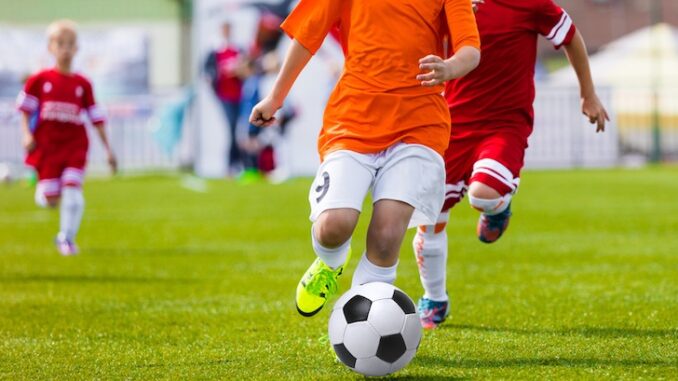
Around these parts, it’s dark and windy and crappy, which means the youth soccer season must be underway. We’re talking grade-school level stuff, not high-school soccer. High-school soccer happens in the Fall and Spring and possibly a bunch of other times. Still, it’s too hard to pin down a source for confirmation since school administrations don’t like nosy reporters prowling about their halls ostensibly to speak with the Athletic Director but secretly looking for organizational drama, scandal, or corruption, which such institutions are ripe with, we suspect.
No, we’re talking little kids, in uniforms, running around the pitch in tightly bunched groups as if they’re sardines forming a writhing bait ball with which to protect themselves against pods of dolphins. Indeed effective soccer strategy consists of players spreading out, giving room for maneuverability and efficient passing. Still, players aged 4-10 have a tough time understanding this concept despite promises of pizza parties and candy-based halftime snacks is they’d just please for the love of all that is holy spread out.
Nope, it’s all kick kick, bump bump, the ball rolls three yards, then kick kick, bump bump, stop to tie shoes, do some spontaneous wiggle dancing, examine own elbow, wonder what the coach and 90% of the parents are yelling about, and other adorable yet maddening and frequently unsanitary behavior.
However, once the little miscreants hit about 11, and especially 12 and 13, we get to witness the joy of ideation and comprehension in action. It should be noted that any phenoms – or those who’ve enjoyed intense, desperate, specialized, and highly-emotional, year-round, parent-inspired training are the exception and have subsequently been drafted – literally drafted – into what is known as Select Leagues. This can happen as early as age 6, at which point agents, coaches, and trainers explain to these children that (ironically) their childhood is over, so let’s go ahead and talk about how moving forward, we’re looking at this as a profession, complete with strength and endurance regimes, sports psychology, ice baths, access to painkillers – the whole nine yards. People are really putting a lot of faith, hope, and effort into this plan, so slay the demons that will impede your success, namely friends, family, and religion.
But for the normals, they just start to get how the whole game works, which makes it way more interesting to observe. Except for the fact formerly 20-minutes halves are now 30-minute halves, and dang, this is still a boring sport to watch in this freezing sleet. But at least there’s some cohesion, some actual gameplay, and some palpable competitive spirit happening, mainly inspired by that one kid’s dad. He keeps yelling instructions at his son, even if the dad’s helpful framework specifically contradicts what the coach tells the poor kid to do. The kid is thus yelling back at his dad, “You’re telling me one thing, she’s telling me another, what I’m I supposed to DO?” with his arms outstretched and hands splayed in confused anguish.
Welcome to the rest of your life, kid.
Once our intrepid youths outgrow bumper car soccer and start playing like ordinary people, it’s impossible to avoid wanting them to absolutely mercilessly crush their opponents, preferably leveraging proven psychological warfare tactics like fake injuries, schizophrenic yelling, threats, mockery, disparagement, body checks when the ref isn’t looking, stepping over a fallen opponent, and all the other terrible behavior we relish in professional athletics.
Unfortunately, our new-age children trade normal competitive conventions for spiritually-sound behavior, including earnest effort, mutual support, joyfulness, and generosity, as evidenced by the disturbing trend of kneeling in supportive solidarity after an opponent takes a tumble crying and grasping various appendages. Then, when little Bobby Joe Whatshisname from The Enemy recovers and limps off the field, they applaud.
They must be learning this from YouTube or something. It’s utterly confusing and undoubtedly worthy of some graduate student’s sociological or anthropological thesis, research study, or whatever else ensures them a healthy buffer from having to go to work for sociopathic C-suite folks.
Meanwhile, it’s common for parents to show an incredible amount of disinterest during the first half of the game. Again, the whole thing just feels like it takes FOREVER, so sure we’ll chat up some bystanders in hopes of finding a kid-friendly taproom for a post-match lunch, a place with both the kind of beer we like and food esteemed enough that the rest of the family won’t complain. But these conversations can be tough sledding given these newfound kids-sports-associated acquaintances may easily steer the discussion towards their work or their house or their upcoming vacation or whatever other lame thing we totally don’t care about because it doesn’t involve our forthcoming lunch. Plus, it’s Saturday man, let’s just sit here and forget ourselves, shall we?
But the second half of the match is a different ball game. We’re in it to win it, yet conflicted, trying to hide our fervent desire for victory and certainly avoid, at all costs, clapping too loudly when we score or yelling slightly mean, slightly encouraging stuff to rub it in like that parent-from-the-other-team does, who is most often a hyper-competitive dad and a total douche.
Like this one time, we were losing by about six goals, and this well-coifed dad on the other sideline was all like, “Yeah, Jack, do it again, don’t stop, score again.” And we were all like, “That guy’s a douche and a dork despite his Cotopaxi Fuego hooded down jacket in appropriate fall colors, which is quite sharp and we secretly want.” However, his kid was really talented, thus the double hat-trick.
Regardless of the game’s outcome, it’s essential to get the hell out of there as soon as possible to grab that lunch. Don’t waste a bunch of time extolling the virtues of resilience (upon a loss) or determination, focus, and teamwork (upon a win) to any offspring within earshot. Frankly, they don’t want to hear it mostly because they’re thinking about tacos too.
If one must stay for whatever annoying reason – coaches giving post-game encouragement, the kid lost his water bottle, we lost our in-laws – it’s vital to lead by example and smile at the other teams’ coaches and parents and say super weird yet non-threatening things like, “Nice touchdowns,” “You’d be a really good pastry chef,” or “Can I borrow 35 dollars?” because that teaches the kids how easy it is to confuse people, make them slightly uncomfortable, and perhaps most importantly reference that moment to their friends.
Which is especially satisfying when executed on that well-coiffed dad.
Overall, youth soccer brings joy to many, anguish to few, perspective to the perceptive, and a chance for kids to learn important stuff on their own, including, subconsciously, which parental behaviors not to emulate. The exercise, teamwork, and learning to compete help them a lot, etc., etc. who cares.
Fine. Get on out there and watch some kids’ soccer hijinks. Or whatever sport or activity suits their fancy. It doesn’t last forever, it’s suitable for everyone involved, plus there’s actual knowledge to be gained, and maybe some fun to be had.
See you on the pitch.




